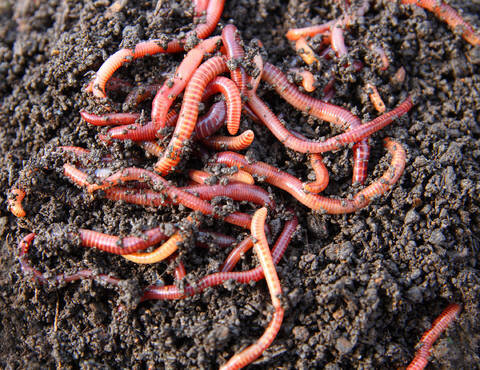Healthy red wigglers: How to begin composting
Healthy red wigglers: How to begin composting
Blog Article
Utilizing Red Wigglers for Efficient Organic Garbage Disposal
Using red wigglers for organic garbage disposal presents a compelling strategy to handling food scraps while advertising environmental sustainability. These worms not only boost waste decomposition but likewise yield important worm castings, which can significantly improve soil wellness. Their ability to process big quantities of natural product with marginal effort positions them as an accessible service for families and areas alike. Nevertheless, understanding the subtleties of establishing up a successful worm bin and keeping an optimal environment is vital for optimizing their advantages. The following action in this process may amaze you.
Benefits of Making Use Of Red Wigglers
Among the most engaging advantages of using red wigglers for natural waste disposal is their remarkable performance in composting. These worms, clinically called Eisenia fetida, are especially adapted for breaking down natural materials, allowing them to process waste as much as twice their body weight daily. This fast decomposition not just accelerates the composting procedure yet likewise creates nutrient-rich worm castings that dramatically improve soil high quality.
In addition, red wigglers contribute to a reduction in land fill waste. By drawing away organic products from landfills, they aid reduce methane emissions-- a powerful greenhouse gas. This ecological advantage is important in the battle against climate adjustment.
Furthermore, red wigglers are low-maintenance and can grow in different settings, making them available for both amateur and knowledgeable composters. Their ability to replicate promptly guarantees a consistent populace, helping with recurring waste processing.
Establishing Your Worm Container
Developing an effective worm bin is essential for making the most of the advantages of composting with red wigglers. The initial step is selecting a suitable container. A container constructed from plastic or timber, with a capacity of 10 to 20 gallons, is optimal. Make sure the container has adequate water drainage holes to avoid excess wetness, as red wigglers prosper in a moist however not soaked atmosphere.
(Lake Hickory Bait)Next, prepare the bedding material, which offers as the worms' environment and food resource. The bin should be positioned in a dark, temperature-controlled location, preferably in between 55 ° F and 77 ° F, to keep worm activity.
As soon as the container is set up, introduce the red wigglers, allowing them to adjust to their new environment. A well-maintained container will certainly not only sustain the wellness of the worms yet likewise assist in effective decomposition of natural waste.
(red worms)
What to Feed Red Wigglers
An understanding of the proper diet for red wigglers is important for keeping a healthy and balanced worm population and enhancing composting effectiveness. Red wigglers grow on a diverse diet plan that mostly is composed of natural materials. Ideal food sources include veggie scraps, fruit peels, coffee premises, eggshells, and shredded paper. These things not just provide vital nutrients yet additionally add to the moisture balance within the worm bin.
It is important to prevent certain foods that can harm the worm population. Red wigglers should not be i loved this fed meat, dairy products, oily foods, or refined products, as these can draw in pests and produce unpleasant odors. red wigglers. Additionally, citrus fruits and spicy foods should be minimized, as their level of acidity can be destructive to worms
To advertise ideal digestion, food should be cut right into smaller pieces, helping with quicker breakdown and intake. Presenting food in moderation is additionally vital; overfeeding can cause anaerobic conditions and bring in undesirable insects. Keeping track of the worm bin for food intake rates will certainly assist guarantee that red wigglers are receiving an ample diet plan while keeping an effective composting environment. Correct feeding methods are important for cultivating a prospering community within the worm container.
Maintaining Your Worm Habitat
A properly maintained worm habitat is necessary for the health and efficiency of red wigglers. To ensure ideal problems, it is vital to keep track of temperature level, moisture, and oygenation within the worm container. Red wigglers flourish in a temperature level range of 55 to 77 degrees Fahrenheit. Surpassing this range can stress the worms, so it is necessary to position the container in a suitable place far from straight sunshine and severe temperatures.
A good regulation of thumb is to keep wetness at approximately 70% to 80%. If the bed linen becomes also damp, it can lead to anaerobic problems that are harmful to the worms.

Using Worm Castings in Horticulture
Rich in nutrients and beneficial microorganisms, worm castings act as a remarkable organic fertilizer for horticulture. Generated via the digestive system procedures of red wigglers, these spreadings include a range of important nutrients, including nitrogen, phosphorus, and potassium, which advertise durable plant growth. Unlike synthetic plant foods, worm spreadings provide a slow-release mechanism, making certain that nutrients are readily available to plants over a prolonged period, therefore lowering the danger of nutrient leaching and soil deficiency.
Along with nutrition web content, worm castings improve dirt framework and aeration, enhancing dampness retention and drainage. The microbial life existing in worm spreadings assists to subdue pathogens and advertises a healthy and balanced dirt community, more profiting plant health and wellness. When included right into the soil or used as a top dressing, worm spreadings can significantly increase seed germination prices, origin development, and total plant vitality.
For optimum results, gardeners ought to use worm spreadings at a price of 1-2 inches per square foot, blending them into the soil or integrating them right into potting blends. Overall, using worm castings is an environment-friendly method to enhancing dirt fertility and making certain thriving garden environments.
Conclusion

Report this page